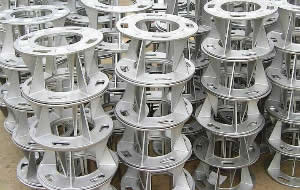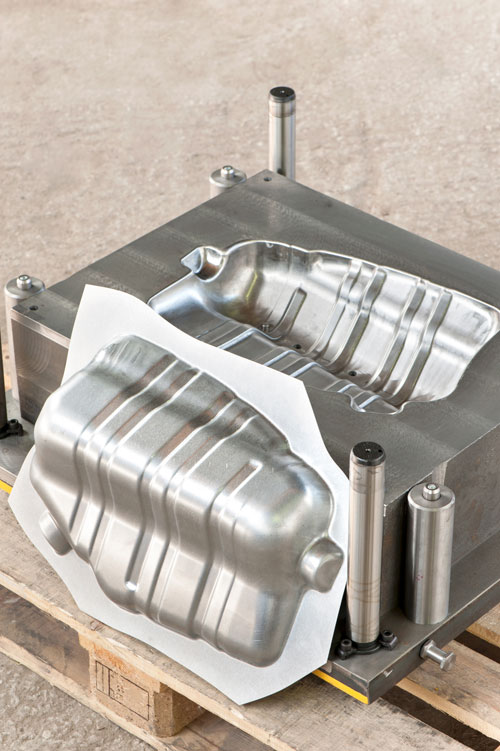What makes a Casting Foundry an important partner in metal fabrication
Checking Out the Important Applications and Use Light Weight Aluminum Foundry in Modern Production
Light weight aluminum foundries play a necessary role in modern-day manufacturing, offering varied sectors with their special residential properties. From auto components that improve gas performance to aerospace frameworks that focus on weight, light weight aluminum's versatility appears. Its applications prolong to construction and customer electronics, highlighting its durability and power effectiveness. However, the technologies in aluminum spreading methods and future trends necessitate a closer examination, as they might redefine its influence on manufacturing.
The Role of Aluminum Foundries in Automotive Production
As the vehicle market progressively prioritizes lightweight products to improve fuel efficiency and performance, light weight aluminum shops have actually ended up being necessary factors to making processes. These shops specialize in creating elements that satisfy the strict demands of modern-day lorries, such as engine blocks, transmission housings, and structural components. Light weight aluminum's positive homes-- such as high strength-to-weight ratio, corrosion resistance, and excellent thermal conductivity-- make it a perfect option for automotive applications.
Moreover, light weight aluminum factories utilize advanced spreading methods, consisting of die spreading and sand casting, to create intricate and durable parts. This capacity allows makers to optimize styles for efficiency while reducing weight. The usage of aluminum likewise sustains sustainability goals, as it is extremely recyclable and reduces energy intake in cars. By facilitating the combination of aluminum into vehicle design, factories play a crucial role in forming the future of the automotive sector, promoting effectiveness and innovation throughout the board.
Aerospace Applications: Lightweight Solutions for Trip
Aluminum factories play a substantial role in the aerospace market, where the need for light-weight materials is extremely important for enhancing fuel effectiveness and performance in airplane. The one-of-a-kind residential or commercial properties of aluminum, including its high strength-to-weight proportion and corrosion resistance, make it an excellent choice for various aerospace components. These components include structural parts, engine casings, and landing equipment, which add to total airplane performance.
Using light weight aluminum alloys, specifically those created via advanced spreading techniques, allows for the production of intricate designs and complex shapes while lessening weight. Furthermore, light weight aluminum's recyclability straightens with the aerospace industry's sustainability objectives, reducing environmental effect. With continuous developments in light weight aluminum foundry modern technologies, manufacturers can optimize production processes, causing increased effectiveness and lowered prices. As the aerospace sector progressively prioritizes advancements that improve efficiency, light weight aluminum shops will certainly remain important to creating light-weight solutions for modern trip.
Structure and Building: Enhancing Architectural Honesty
In the structure and building market, a significant focus is positioned on improving structural honesty through the use of aluminum. Understood for its high strength-to-weight ratio, light weight aluminum provides durability without endangering on weight, which is vital in modern-day architectural layouts. Its resistance to rust further ensures longevity, making it an excellent material for various architectural components, consisting of beam of lights, structures, and cladding.
Aluminum also promotes ingenious layout possibilities, permitting designers and designers to produce cosmetically pleasing structures while keeping safety and security requirements. The product's adaptability enables its application in both industrial and household jobs, from skyscrapers to bridges. Furthermore, innovations in aluminum factory techniques have actually improved the precision of light weight aluminum parts, guaranteeing they satisfy rigid building ordinance. On the whole, the integration of aluminum in construction not only enhances structural stability however likewise adds to lasting structure methods, provided its recyclability and energy-efficient manufacturing approaches.
Customer Electronic Devices: The Surge of Light Weight Aluminum in Modern technology
In the domain name of customer electronic devices, light weight aluminum has actually gained prominence because of its light-weight layout benefits and premium thermal conductivity. This change not just improves product mobility but also improves device performance by efficiently dissipating warmth. As modern technology continues to evolve, the role of aluminum in developing reliable and sleek tools is significantly significant.
Lightweight Layout Advantages
As customer electronics develop, the need for light-weight yet durable materials has surged, making aluminum a significantly prominent option amongst makers. Its reduced thickness enables the production of sleek devices that are easy to make use of and lug, significantly enhancing transportability. The strength-to-weight ratio of light weight aluminum assurances that products can hold up against everyday damage without jeopardizing efficiency. Furthermore, the malleability of light weight aluminum allows manufacturers to make complex shapes and kinds, even more contributing to cutting-edge aesthetic appeals and functionality. This light-weight feature additionally plays a crucial function in power effectiveness, as lighter tools need much less energy to run. Because of this, light weight aluminum not only fulfills the developing visual demands however also lines up with the modern-day concentrate on sustainability in consumer electronic devices.
Thermal Conductivity Benefits
Thermal conductivity is a vital factor in the performance of customer electronic devices, and aluminum excels in this domain name. Its high thermal conductivity allows for effective warmth dissipation, which is important for preserving optimum operating temperature levels in devices such as smartphones, laptops, and video gaming consoles. By promoting rapid heat transfer away from delicate elements, light weight aluminum aids prevent overheating, consequently boosting efficiency and prolonging device durability. Moreover, the light-weight nature of light weight aluminum enhances its thermal homes, making it an ideal choice for portable technology. As manufacturers increasingly prioritize performance and power efficiency, aluminum's duty in thermal monitoring becomes much more substantial, bring about its expanding fostering in modern-day digital layouts. This pattern highlights aluminum's significance in customer electronic devices technology.
Marine Industry: Rust Resistance in Harsh Atmospheres
Rust resistance is a vital consider the marine industry, where tools and frameworks are regularly exposed to harsh deep sea atmospheres. Aluminum, particularly in its alloy forms, offers substantial benefits hereof. Its all-natural oxide layer supplies a protective obstacle that avoids corrosion, making it excellent for vessels, anchors, and other aquatic applications.
Marine-grade aluminum alloys, such as 5083 and 6061, are especially created to endure the harsh impacts of deep sea and atmospheric problems. These alloys not only stand up to rust but additionally preserve architectural stability and toughness gradually. Applications range from hulls and superstructures of ships to elements in offshore systems.
The light-weight nature of aluminum more enhances its suitability, making it possible for enhanced gas efficiency and convenience of handling - aluminum foundry. As the aquatic industry remains to concentrate on sturdiness and efficiency, aluminum continues to be a crucial material selection for standing up to corrosion sought after marine settings
Technologies in Aluminum Spreading Techniques
While standard light weight aluminum casting Resources techniques have served the industry well, current advancements are transforming the landscape of light weight aluminum production. Methods such as 3D printing of molds and cores are gaining traction, enabling quick prototyping and decreased lead times. This innovation enables producers to produce complicated geometries that were formerly tough to attain with standard spreading approaches. In addition, innovations in die-casting technology, including the use of high-pressure die-casting (HPDC), have improved the accuracy and surface area coating of actors light weight aluminum parts, bring about enhanced efficiency in numerous applications.
Moreover, the adoption of financial investment spreading has actually permitted greater design flexibility and minimized product waste. aluminum foundry. Developments in alloy compositions are likewise significant, as they enhance mechanical buildings and deterioration resistance. Generally, these growths not just simplify manufacturing procedures yet additionally contribute to even more sustainable techniques within the light weight aluminum factory industry, making it adaptable to the advancing needs of contemporary manufacturing
Future Trends in Light Weight Aluminum Factory Manufacturing
The future of aluminum foundry production is positioned for substantial makeover with automation, enhancing efficiency and accuracy Bonuses in making procedures. Sustainable techniques are progressively coming to be a priority, as factories seek to lessen their environmental effect while meeting growing governing needs. In addition, developments in alloy growth will allow the development of more powerful, lighter materials tailored for varied applications, driving innovation in the industry.
Automation in Factory Processes

Lasting Manufacturing Practices
A growing focus on lasting manufacturing methods is reshaping the future of aluminum shop production. Sector leaders are progressively embracing energy-efficient technologies and recycling campaigns to lessen waste and decrease carbon impacts. Using recycled light weight aluminum significantly reduces power usage compared to main aluminum manufacturing, making it a preferred selection for ecologically conscious makers. On top of that, cutting-edge casting techniques are being created to enhance product efficiency and minimize emissions. Business are also investing in eco-friendly energy resources, such as solar and wind, to power their operations sustainably. aluminum casting company. By incorporating these practices, the light weight aluminum foundry market not just meets governing requirements however also reacts to customer demand for greener items, ultimately leading the means for a much more lasting manufacturing landscape
Advanced Alloy Advancement
Advancements in light weight aluminum alloy development are readied to play a substantial role in the future of factory manufacturing, particularly as sustainability and performance needs escalate. The industry is significantly concentrating on creating high-strength, light-weight alloys that can withstand severe problems while decreasing environmental influence. Researchers are checking out innovative structures, such as aluminum-lithium and aluminum-scandium alloys, which assure enhanced mechanical homes and reduced weight. Furthermore, the assimilation of advanced manufacturing methods, consisting of additive production and precision casting, permits more complex geometries and minimized material waste. As governing pressures and consumer preferences shift towards greener alternatives, the development of energy-efficient and recyclable alloys will certainly be crucial. The future landscape of light weight aluminum shop manufacturing rests on these advancements in alloy technology.

Regularly Asked Inquiries
What Are the Ecological Effects of Light Weight Aluminum Factory Workflow?
Aluminum foundry operations can cause significant ecological impacts, consisting of greenhouse gas exhausts, power usage, and waste generation. Furthermore, improper monitoring of pollutants might lead to soil and water contamination, affecting neighborhood ecological communities and areas.
Exactly How Does Light Weight Aluminum Recycling Affect Shop Processes?
Light weight aluminum reusing improves factory processes by offering an economical raw product, minimizing power usage and exhausts. This sustainable practice enhances efficiency, minimizes waste, and supports the circular economic situation, profiting both suppliers and the setting.
What Security Steps Are Executed in Light Weight Aluminum Foundries?
Light weight aluminum factories apply different click over here precaution, including personal safety devices, appropriate ventilation systems, normal safety and security training, fire prevention protocols, and tools upkeep procedures to decrease dangers and guarantee a secure workplace for all workers.
How Do Foundries Ensure Quality Assurance in Aluminum Casting?
Shops guarantee quality assurance in light weight aluminum casting via extensive product assessments, precise temperature level tracking, standard procedures, and normal testing of cast items. These measures assist preserve uniformity, reduce problems, and satisfy sector specifications successfully.
What Are the Price Factors in Aluminum Factory Production?
Expense aspects in light weight aluminum shop manufacturing include raw material costs, energy usage, labor expenses, devices maintenance, and overhead costs. Furthermore, production volume and complexity of designs significantly influence overall manufacturing prices and profitability.
As the automotive industry significantly focuses on light-weight products to boost gas performance and performance, aluminum foundries have become vital contributors to manufacturing procedures. Light weight aluminum factories play a considerable role in the aerospace sector, where the demand for light-weight products is vital for improving fuel performance and efficiency in aircraft. Furthermore, developments in aluminum foundry strategies have actually boosted the accuracy of aluminum components, ensuring they fulfill rigorous building codes. While traditional light weight aluminum spreading techniques have actually served the sector well, current developments are changing the landscape of aluminum production. The usage of recycled aluminum considerably reduces energy intake compared to key aluminum manufacturing, making it a favored selection for ecologically aware makers.